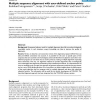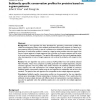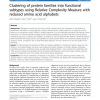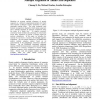BIOINFORMATICS
2006
14 years 6 months ago
2006
Multiple Alignment is a new interface for performing and analyzing multiple protein structure alignments. It enables viewing levels of sequence and structure similarity on the ali...
ALMOB
2006
14 years 6 months ago
2006
Background: Automated software tools for multiple alignment often fail to produce biologically meaningful results. In such situations, expert knowledge can help to improve the qua...
BMCBI
2008
14 years 6 months ago
2008
Background: A new algorithm has been developed for generating conservation profiles that reflect the evolutionary history of the subfamily associated with a query sequence. It is ...
BMCBI
2010
14 years 6 months ago
2010
Background: Phylogenetic analysis can be used to divide a protein family into subfamilies in the absence of experimental information. Most phylogenetic analysis methods utilize mu...
BMCBI
2008
14 years 6 months ago
2008
Background: Structural alignment of RNAs is becoming important, since the discovery of functional non-coding RNAs (ncRNAs). Recent studies, mainly based on various approximations ...
AAAI
2004
14 years 7 months ago
2004
Obtaining an accurate multiple alignment of protein sequences is a difficult computational problem for which many heuristic techniques sacrifice optimality to achieve reasonable r...
ISAAC
2003
Springer
14 years 11 months ago
2003
Springer
In this paper some of the most fundamental problems in computational biology are proved intractable. The following problems are shown NP-hard for all binary or larger alphabets und...
CSB
2003
IEEE
14 years 11 months ago
2003
IEEE
This paper describes a new strategy for designing degenerate primers for a given multiple alignment of amino acid sequences. Degenerate primers are useful for amplifying homologou...
CSB
2005
IEEE
15 years 2 days ago
2005
IEEE
We present TreeRefiner, a tool for refining multiple alignments of biological sequences. Given a multiple alignment, a phylogenetic tree, and scoring parameters as input, TreeRefi...




